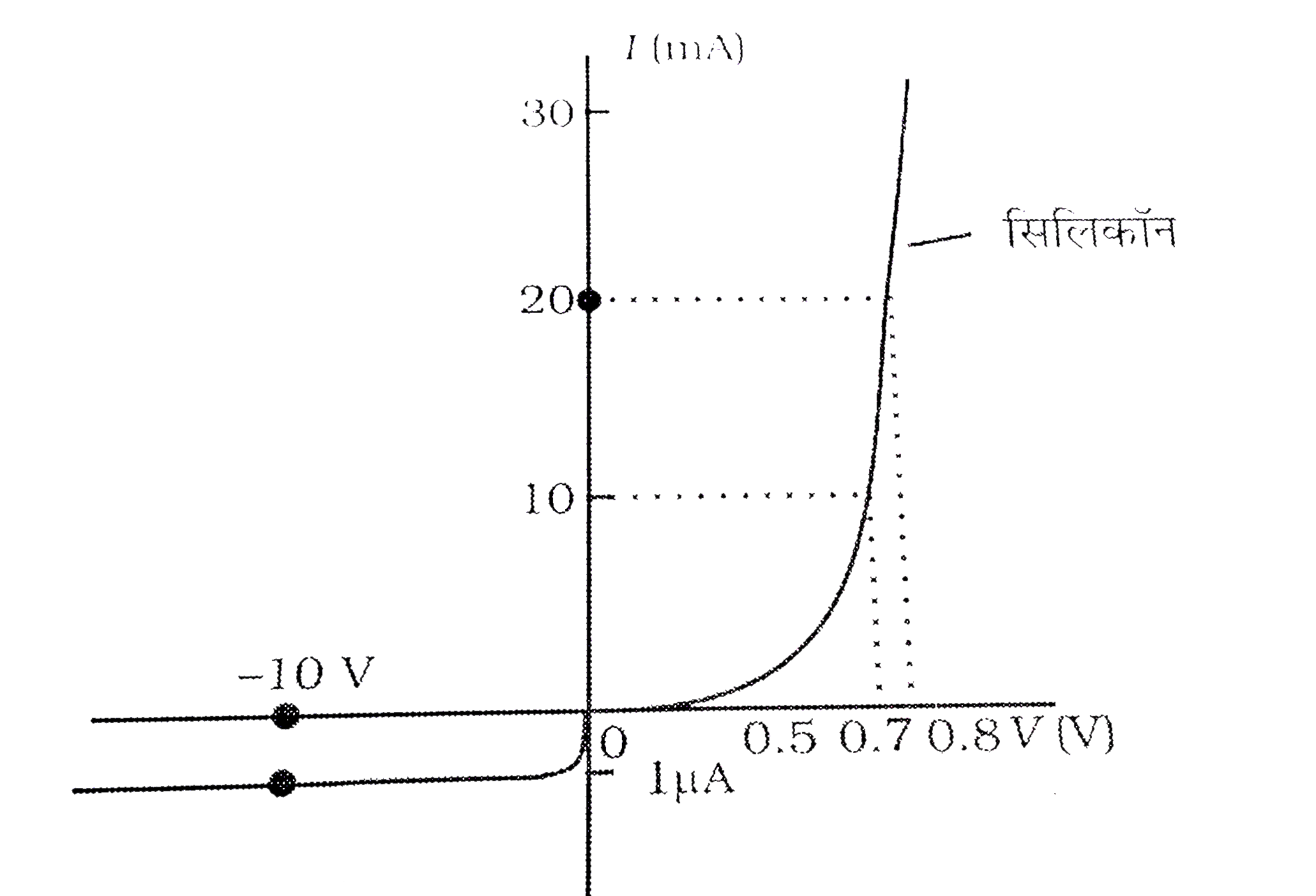The V-I characteristic of a silicon diode is shown in the Fig. 14.17. Calculate the resistance of the diode at (a)ID=15 mA and (b) VB=−10V
 Solution in Gujrati
Solution in Gujrati
Considering the diode characteristics as a straight line between I = 10 mA to I = 20 mA passing through the origin, we can calculate the resistance using Ohm’s law.
(a) From the curve, at I = 20mA, V= 0.8 V, I= 10mA, V= 0.7 V
rfb=ΔV/ΔI=0.1V/10mA=10Ω
(b) From the curve at V=−10V,I=−1μA,
Topper's Solved these Questions
- SEMICONDUCTOR ELECTRONICS: MATERIALS, DEVICES AND SIMPLE CIRCUITSBook:NCERT GUJARATIChapter:SEMICONDUCTOR ELECTRONICS: MATERIALS, DEVICES AND SIMPLE CIRCUITSExercise:EXERCISES
Explore 7 Videos
- SEMICONDUCTOR ELECTRONICS: MATERIALS, DEVICES AND SIMPLE CIRCUITSBook:NCERT GUJARATIChapter:SEMICONDUCTOR ELECTRONICS: MATERIALS, DEVICES AND SIMPLE CIRCUITSExercise:ADDITIONAL EXERCISES
Explore 8 Videos
- RAY OPTICS AND OPTICAL INSTRUMENTSBook:NCERT GUJARATIChapter:RAY OPTICS AND OPTICAL INSTRUMENTSExercise:EXERCISES
Explore 40 Videos
- WAVE OPTICSBook:NCERT GUJARATIChapter:WAVE OPTICSExercise:EXERCISES
Explore 26 Videos
Similar Questions
In an n-type silicon, which of the following statement is true:
View SolutionThe number of silicon atoms per m3 is 5×1028. This is doped simultaneously with 5×1022 atoms per m3 of Arsenic and 5×1020 per m3 atoms of Indium. Calcualte the number of electrons and holes. Given that ni=1.5×1016m−3. Is the material n-type or p-type?
View SolutionA small candle, 2.5 cm in size is placed at 27 cm in front of a concave mirror of radius of curvature 36 cm. At what distance from the mirror should a screen be placed in order to obtain a sharp image? Describe the nature and size of the image. If the candle is moved closer to the mirror, how would the screen have to be moved?
View SolutionMonochromatic light of wavelength 589 nm is incident from air on a water surface. What are the wavelength, frequency and speed of (a) reflected, and (b) refracted light? Refractive index of water is 1.33.
View SolutionThe V-I characteristics of silicon diode is shown in Fig. Calculate the diode resistance in forward bias at V=+0.9V reverse bias V=-3.0V .
View SolutionThe V-I characteristics of a silicon diode is shown in the Fig. . Calculate the resistsnce of the diode at I_(D)=15mA and V_(D)=-10V .
View SolutionThe V-I characteristic of a silicon diode is shown in the Fig. Calculate the resistance of the diode at (a) I_(D) = 15 mA and (b) V_(D) = -10 V . .
View SolutionThe volt-ampere characteristic of a silicon diode is shown in fig. Determine the resistance of the diode at (i) I_(D)=20mA and (ii) V_(D)=-10V .
View SolutionThe V-I characteristic of a silicon diode is shown in figure . The resistance of the diode at ID=15 mA is

View Solutionकिसी सिलिकॉन डायोड का V−I अभिलाक्षणिक चित्र में दर्शाया गया है। डायोड का प्रतिरोध (a) ID=15mA तथा (b) VD=−10V पर परिकलित कीजिए।

View Solutionसिलिकॉन डायोड के निम्न प्रेक्षणों से डायोड प्रतिरोध की गणना कीजिए
V = 0.8 V पर I= 20 mA तथा V = 0.7 V पर I = 10 mA.
View Solutionकिसी सिलिकॉन डायोड का V-I अभिलाक्षणिक चित्र में दर्शाया गया है| डायोड का प्रतिरोध (a) ID=15mA तथा (b) VD=−10V पर परिकलित कीजिए|

View SolutionThe V-I characteristic of a silicon diode is as show in the following calulate the resistance of the diode at (i) I_(D)=15 mA and (ii) V_(D)=10 V
View SolutionThe V-I characteristic of a silicon diode is shown in the figure . Calculate the resistance of the diode at (a) ID=15mA and (b) VD=−10V

View SolutionThe V-I characteristic of a silicon diode is shown in the Fig. 14.17. Calculate the resistance of the diode at (a)ID=15 mA and (b) VB=−10V

View Solution